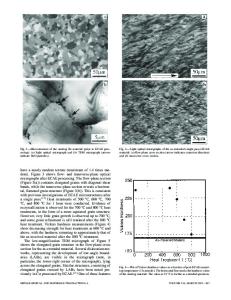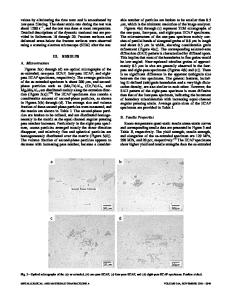Microstructure and properties of copper and aluminum alloy 3003 heavily worked by equal channel angular extrusion
- PDF / 2,730,292 Bytes
- 11 Pages / 612 x 792 pts (letter) Page_size
- 97 Downloads / 327 Views
I.
INTRODUCTION
NANO- and submicrocrystalline materials have recently stimulated considerable interest among researchers.[1] These materials are characterized by a very fine grain size and a large amount of grain boundary area (and volume). The presence of a large amount of grain boundary area results in unusual and extraordinary changes in both mechanical and physical properties. Recent investigations testify that severe plastic deformation is an effective method for forming submicron-grained materials.[2] Different techniques have been used to introduce large quantities of plastic strain into metals. Rolling is the most conventional technique, but higher strain levels have been achieved more recently for example by torsion under pressure,[3] by a combination of compression and torsion,[4] by cyclic extrusion,[5] or by a specific method involving simple shear inside a localized zone.[6] True strains from about 8 to 14 have been obtained. A method for imposing large plastic strains to materials, called equal channel angular extrusion (ECAE), that was developed[7] in the former Soviet Union and recently introduced in the United States offers many advantages over conventional deformation processes.[8–15] The present investigation used ECAE to severely deform two materials: CDA STEPHANE FERRASSE, formerly Graduate Student with Texas A&M University, is now R&D Engineer with SOLLAC (USINOR SACILOR Group) in Dunkerque, France. K. TED HARTWIG and RAMON E. GOFORTH, Associate Professors, are with the Department of Mechanical Engineering, Texas A&M University, College Station, TX 77843-3123. VLADIMIR M. SEGAL, formerly Associate Research Engineer, Department of Mechanical Engineering, Texas A&M University, is Principal Research Scientist with Johnson Matthey Electronics, Spokane, WA 99216. Manuscript submitted November 27, 1995. METALLURGICAL AND MATERIALS TRANSACTIONS A
101 oxygen-free copper and the non-heat-treatable wrought aluminum alloy 3003 (Al-0.12 pct Cu-1.2 pct Mn). The purpose of this work is to determine some effects of specific parameters of the ECAE technique on the microstructure and the properties of the two materials. It will also identify the structural alteration mechanisms involved during ECAE deformation. II.
EXPERIMENTAL PROCEDURE
The peculiarity of the ECAE technique comes from its ability to produce deformation by simple shear in bulk sections of material, as shown in Figure 1. A well-lubricated billet is forced by a punch through two channels of nearly equal cross section intersecting at an angle (2f) of 90 deg. A thin layer in the billet located at the crossing plane of the channels is deformed by simple shear at an angle w from the extrusion axis, as shown in Figure 1. As extrusion occurs, layer after layer, all the material is uniformly subjected to deformation except at the two ends of the billet.[8] It is important that intensive working by ECAE is performed on bulk material under relatively low pressure and load, which are unattainable circumstances for other ‘‘ideal’’ forming operations.[1
Data Loading...











